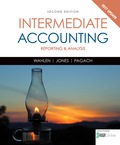
EBK INTERMEDIATE ACCOUNTING: REPORTING
2nd Edition
ISBN: 9781337268998
Author: PAGACH
Publisher: YUZU
expand_more
expand_more
format_list_bulleted
Question
Chapter 20, Problem 15P
To determine
Identify the type of lease from both lessor (Company R) and lessee (Company C) point of view.
2.
To determine
Explain the reason for that the final two criteria are not applicable when classifying a lease of land.
Expert Solution & Answer
Want to see the full answer?
Check out a sample textbook solution
Students have asked these similar questions
What are the variable maintenance cost per unit
I am trying to find the accurate solution to this general accounting problem with the correct explanation.
Solve with explanation and accounting question
Chapter 20 Solutions
EBK INTERMEDIATE ACCOUNTING: REPORTING
Ch. 20 - Prob. 1GICh. 20 - What is the difference between the lessee and...Ch. 20 - Prob. 3GICh. 20 - Prob. 4GICh. 20 - Prob. 5GICh. 20 - Prob. 6GICh. 20 - What are the two types of lease classifications...Ch. 20 - Prob. 8GICh. 20 - Prob. 9GICh. 20 - Prob. 10GI
Ch. 20 - Prob. 11GICh. 20 - Describe the difference between how a lessee would...Ch. 20 - Prob. 13GICh. 20 - Prob. 14GICh. 20 - Prob. 15GICh. 20 - Prob. 16GICh. 20 - Prob. 17GICh. 20 - Prob. 18GICh. 20 - Prob. 19GICh. 20 - Prob. 20GICh. 20 - Prob. 21GICh. 20 - Prob. 1MCCh. 20 - Prob. 2MCCh. 20 - Prob. 3MCCh. 20 - Prob. 4MCCh. 20 - Prob. 5MCCh. 20 - Prob. 6MCCh. 20 - Prob. 7MCCh. 20 - Prob. 8MCCh. 20 - Rent received in advance by the lessor for an...Ch. 20 - Prob. 10MCCh. 20 - Next Level Keller Corporation (the lessee) entered...Ch. 20 - Prob. 2RECh. 20 - Prob. 3RECh. 20 - Prob. 4RECh. 20 - Prob. 5RECh. 20 - Prob. 6RECh. 20 - Prob. 7RECh. 20 - Prob. 8RECh. 20 - Prob. 9RECh. 20 - Prob. 10RECh. 20 - Prob. 1ECh. 20 - Prob. 2ECh. 20 - Lessee Accounting Issues Sax Company signs a lease...Ch. 20 - Prob. 4ECh. 20 - Prob. 5ECh. 20 - Prob. 6ECh. 20 - Prob. 7ECh. 20 - Lessor Accounting with Receipts at Beginning of...Ch. 20 - Determining Type of Lease and Subsequent...Ch. 20 - Prob. 10ECh. 20 - Prob. 11ECh. 20 - Prob. 12ECh. 20 - Prob. 13ECh. 20 - Prob. 14ECh. 20 - Prob. 15ECh. 20 - Determining Type of Lease and Subsequent...Ch. 20 - Prob. 2PCh. 20 - Prob. 3PCh. 20 - Lessee Accounting Issues Timmer Company signs a...Ch. 20 - Prob. 5PCh. 20 - Prob. 6PCh. 20 - Sales-Type Lease with Receipts at End of Year...Ch. 20 - Prob. 8PCh. 20 - Prob. 9PCh. 20 - Prob. 10PCh. 20 - Prob. 11PCh. 20 - Prob. 12PCh. 20 - Prob. 13PCh. 20 - Prob. 14PCh. 20 - Prob. 15PCh. 20 - Prob. 1CCh. 20 - Prob. 2CCh. 20 - Prob. 3CCh. 20 - Classification of Leases Part a. Capital leases...Ch. 20 - Prob. 5CCh. 20 - Prob. 6CCh. 20 - Prob. 7CCh. 20 - Prob. 8CCh. 20 - Prob. 9CCh. 20 - Prob. 10CCh. 20 - Prob. 11CCh. 20 - Prob. 12CCh. 20 - Prob. 13CCh. 20 - Prob. 14CCh. 20 - Prob. 15C
Knowledge Booster
Similar questions
arrow_back_ios
SEE MORE QUESTIONS
arrow_forward_ios
Recommended textbooks for you
 Intermediate Accounting: Reporting And AnalysisAccountingISBN:9781337788281Author:James M. Wahlen, Jefferson P. Jones, Donald PagachPublisher:Cengage Learning
Intermediate Accounting: Reporting And AnalysisAccountingISBN:9781337788281Author:James M. Wahlen, Jefferson P. Jones, Donald PagachPublisher:Cengage Learning Financial Accounting: The Impact on Decision Make...AccountingISBN:9781305654174Author:Gary A. Porter, Curtis L. NortonPublisher:Cengage Learning
Financial Accounting: The Impact on Decision Make...AccountingISBN:9781305654174Author:Gary A. Porter, Curtis L. NortonPublisher:Cengage Learning

Intermediate Accounting: Reporting And Analysis
Accounting
ISBN:9781337788281
Author:James M. Wahlen, Jefferson P. Jones, Donald Pagach
Publisher:Cengage Learning


Financial Accounting: The Impact on Decision Make...
Accounting
ISBN:9781305654174
Author:Gary A. Porter, Curtis L. Norton
Publisher:Cengage Learning